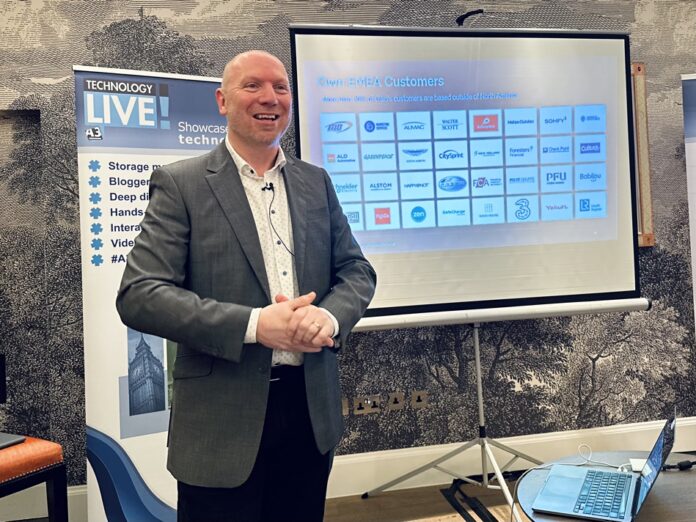Analysis. The Own Company provides SaaS app backup, and its growth rate testifies to an over-supplied SaaS app backup market and fragmented customer buying patterns.
Update. HYCU R-Graph comment added at end of story. 28 February 2024.

Graham Russell, its market intelligence director, told an audience of hacks and analysts at an A3 Technology Live event in London that it has 6,700 customers and: “We are the single largest Salesforce backup supplier.” He said the vast majority of its revenue comes from Salesforce customers.
The Own Company, which has one of the worst company names in Google search history – try searching for “Own” and you’ll get hundreds of Oprah Winfrey references – was started up in Tel Aviv in 2012, and has amassed a war chest of over $500 million through six funding rounds, with the last two raising $407.5 million in 2021. Those funding total and the successive funding rounds reflect its high growth rate.
The startup backs up customer data in the Salesforce, Microsoft Dynamics, and ServiceNow SaaS applications to the AWS and Azure clouds. SAP is a likely next target. It has a partnership with Cohesity, which protects Microsoft 365. The biz has passed the $200 million ARR point and, Russell predicted: “Profitability is imminent.” It’s not surprising – he revealed some customers are coughing up a million dollars a year to the Own Company.
There is plenty of room for growth just within the Salesforce market, as there are more than 200,000 Salesforce customers. However Russell is aware of some twenty Salesforce backup suppliers – hence the over-supply comment above. Apart from Salesforce’s own but rudimentary internal backup, we know of Asigra, CloudAlley, Commvault, Druva, HYCU, Spanning, Veeam, and other external suppliers – but not 20 of them.
The majority, we understand, of Salesforce-using Own Company customers have existing on-premises backup arrangements. That means that they have a separate Own backup silo, adding complexity and making the provision of an overall view of their data protection requirements harder to obtain. Why is this?
Russell told us he knew of one customer with existing Commvault backup arrangements organized through the IT department. But Salesforce use was not provided through the IT department and its buyers chose Own Backup because it was the best of breed. In other words, the Own Company, and other SaaS-focussed suppliers, are benefitting from fragmented buying patterns by their customers.
If customers want an overall view of their data protection risk then, unless they have a single supplier, there is no easy way to get it. Of course backup suppliers could partner to feed information to each other’s management dashboards but, generally, they don’t. There is little customer demand and no overall backup industry concern about the issue. Do you know of a backup suppliers’ trade association? Me neither.
Think about collecting historical data and analyzing it, possibly by using generative AI. Unless you collate all this information in a central data lake/data warehouse/lakehouse there is no one source for such data, making life harder for the analysts.
Salesforce has some 200,000 customers. If the Own Company has around 6.500 of them, then we could assume that the 20 Salesforce backup suppliers collectively protect, say, 20,000 Salesforce customers – a tenth of the total. That means they each have a vast market to penetrate: 180,000 prospects. They don’t have to think about such things as cooperating with other Salesforce protection suppliers to make customers’ lives easier. Far-seeing customers might mandate that all data protection arrangements are made through central IT to prevent data protection silo sprawl. That would help head off future difficulties in understanding an organization’s global data loss risk and providing comprehensive data for analytics and AI.
Let’s step back a moment and think of other popular SaaS apps such as Microsoft’s Dynamics and 365, Service Now, Atlassian, Google Workspace, and many more. Will protecting them contribute to more SaaS app backup silo sprawl? Likely yes – and the scope of the problem gets worse still. Unless there is central buying for data protection then SaaS backup silo sprawl and attendant problems will become endemic.
Bootnote. HYCU told us that one of the intents of its R-Graph was to help with a way of visualizing where data was and what was protected and unprotected.








